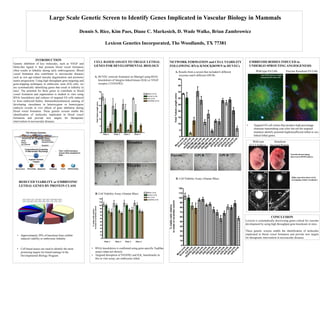
ARVO 2007 Developmental Biology Program
- 1. Large Scale Genetic Screen to Identify Genes Implicated in Vascular Biology in Mammals Dennis S. Rice, Kim Paes, Diane C. Markesich, D. Wade Walke, Brian Zambrowicz Lexicon Genetics Incorporated, The Woodlands, TX 77381 INTRODUCTION Genetic inhibition of key molecules, such as VEGF and Delta-like ligand 4, that promote blood vessel formation often results in lethality during early embryogenesis. Blood vessel formation also contributes to neovascular diseases such as wet age-related macular degeneration and promotes tumor progression. Using high throughput gene-targeting and gene-trapping techniques in embryonic stem (ES) cells, we are systematically identifying genes that result in lethality in mice. The potential for these genes to contribute to blood vessel formation and organization is studied in vitro using RNAi knockdown and cultures of targeted ES cells induced to form embryoid bodies. Immunohistochemical staining of developing vasculature in heterozygous or homozygous embryos reveals in vivo effects of gene inhibition during blood vessel formation. These genetic screens enable the identification of molecules implicated in blood vessel formation and provide new targets for therapeutic intervention in neovascular diseases. anti-PKC CHA DAP ENZ GPR INH KNS MAS MEM MSC NHR PHD PHO PRT PSC RAP SEC SGT SKL TRA TRF REDUCED VIABILITY or EMBRYONIC LETHAL GENES BY PROTEIN CLASS The Human Genome •GPCRs •Kinases •Ion Channels •Key Enzymes •Secreted Proteins •Receptors Superior Human Targets Comprehensive Screening of Mammalian Physiology Knock Out All Druggable Genes Immunology Metabolism Cancer OphthalmologyNeuroscience • Over 4,000 knockout mouse lines analyzed to date Cardiology CELL BASED ASSAYS TO TRIAGE LETHAL GENES FOR DEVELOPMENTAL BIOLOGY Plate 1 Plate 2 Plate 3 Plate 4 Mock Scrambled ILK VEGFR2 • RNAi knockdown is confirmed using gene-specific TaqMan assays (data not shown). • Targeted disruption of VEGFR2 and ILK, benchmarks in this in vitro assay, are embryonic lethal. 0 5 10 15 20 25 30 Mock (n=4) Scram (n=6) ILK (n=4) VEGFR2 (n=4) TotalTubuleLength(mm) 0 10 20 30 40 50 60 70 80 90 100 110 120 Mock (n=4) Scram (n=6) ILK (n=4) VEGFR2 (n=4) %viablecellsrelative tomeanofscramblecontrol Plate 1 Plate 2 Plate 3 Plate 4 A. HUVEC network formation on Matrigel using RNAi knockdown of Integrin-linked kinase (ILK) or VEGF receptor 2 (VEGFR2) B. Cell Viability Assay (Alamar Blue) M ock (n=4) Scram (n=6) ILK (n=4) VEG FR 2 (n=4) EN ZYM E (n=6) EN ZYM E (n=6) EN ZYM E (n=6) EN ZYM E (n=6) EN ZYM E (n=6) EN ZYM E (n=6) G PC R (n=6) G PC R (n=6) G PC R (n=6) G PC R (n=6) G PC R (n=6) G PC R (n=6) 0 5 10 15 20 25 30 35 40 45 TotalTubuleLength(mm) NETWORK FORMATION and CELL VIABILITY FOLLOWING RNAi KNOCKDOWN in HUVECs • Targeted ES cell clones that produce high percentage chimeras transmitting coat color but not the targeted mutation identify potential haploinsufficient lethal or sex- linked lethal genes. Wild type ES Cells Enzyme Knockout ES Cells Anti-CD31 (green) or alpha smooth muscle actin (red) • Approximately 20% of knockout lines exhibit reduced viability or embryonic lethality • Cell based assays are used to identify the most promising targets for timed-matings in the Developmental Biology Program CONCLUSION Lexicon is systematically discovering genes critical for vascular development by using high throughput gene knockouts in mice. These genetic screens enable the identification of molecules implicated in blood vessel formation and provide new targets for therapeutic intervention in neovascular diseases. EMBRYOID BODIES INDUCED to UNDERGO SPROUTING ANGIOGENESIS A. Results from a screen that included 6 different enzymes and 6 different GPCRs M ock (n=4) Scram (n=6) ILK (n=4) VEG FR 2 (n=4) EN Z (n=6) EN Z (n=6) EN Z (n=6) EN Z (n=6) EN Z (n=6) EN Z (n=6) G PR (n=6) G PR (n=6) G PR (n=6) G PR (n=6) G PR (n=6) G PR (n=6) 0 10 20 30 40 50 60 70 80 90 100 110 120 %viablecellsrelative tomeanofscramblecontrol Enzyme GPCR GPCR B. Cell Viability Assay (Alamar Blue) Wild type Knockout E13.5 Embryo Secreted Protein AS PD3 Sense PD6 PD6 NFL CC Vascular hemorraging observed in HOM embryo High expression observed in developing retinal vasculature